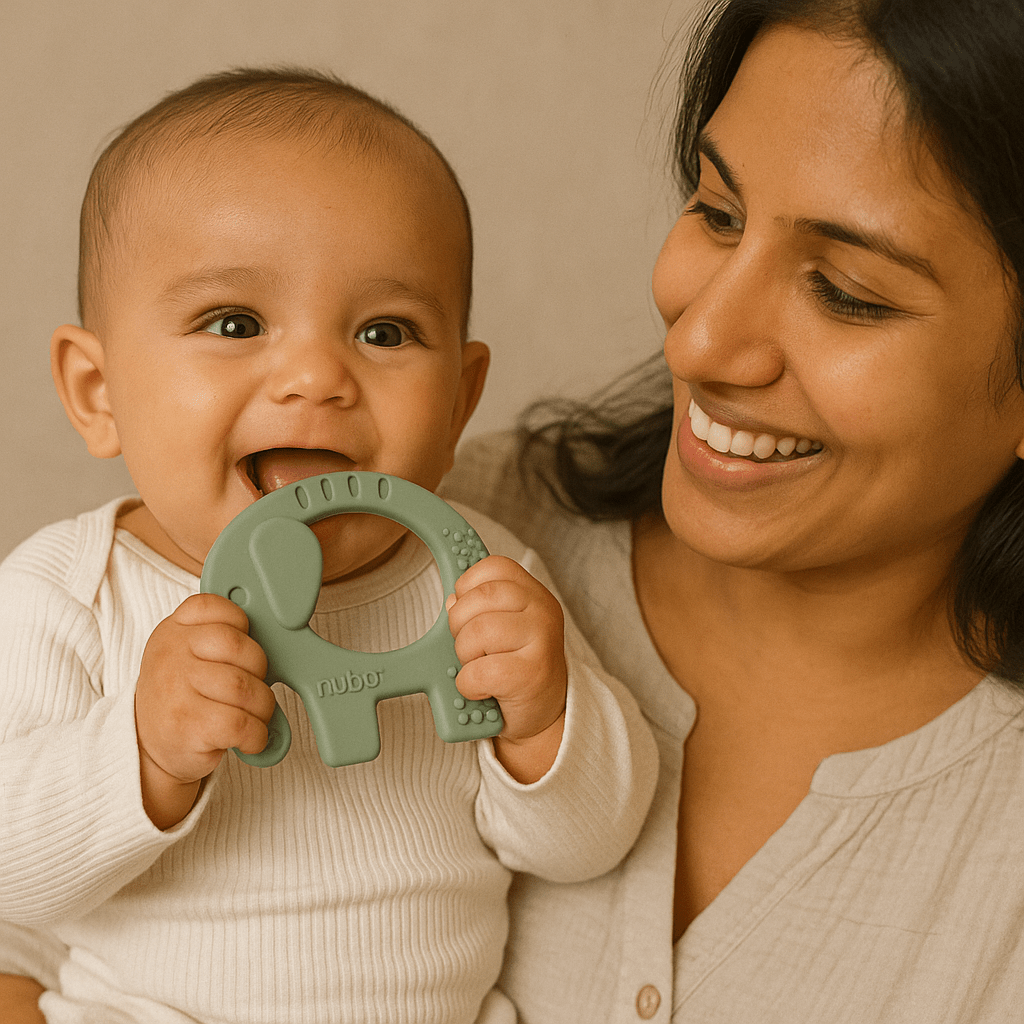Article: when do babies start teething? a complete timeline & soothing solutions
when do babies start teething? a complete timeline & soothing solutions
Teething is one of the most exciting milestones in your baby’s development — but it can also be one of the most challenging. As those tiny pearly whites start to emerge, you may notice changes in your baby’s mood, sleep, and even eating habits.
So, when do babies actually start teething, and what can you expect during this journey? This guide will walk you through the teething timeline month by month, highlight common symptoms, and share proven ways to soothe your little one using safe, baby-friendly solutions like nubokind infant silicone teethers.
📅 When do babies start Teething?
Most babies begin teething between 4 to 7 months, but it can vary. Some infants may show signs of teething as early as 3 months, while others may not get their first tooth until around 12 months.
🗓 Baby Teething Timeline (month-by-month guide)
0–3 months: Pre-Teething Stage
- Increased saliva production begins.
- Babies start chewing on fingers, fists, and toys.
- Early signs of teething discomfort may appear.
4–7 months: First Teeth Erupt
-
The bottom front teeth (lower central incisors) usually come in first.
-
Common symptoms: excessive drooling, gum swelling, irritability.
-
Babies may wake up more frequently at night.
8–12 months: Top front Teeth appear
- The upper central incisors follow.
- Lateral incisors (teeth beside the front ones) come next.
-
Your baby may begin trying soft finger foods using their new teeth.
12–18 months: First Molars Emerge
- Back molars begin to appear.
- Due to their size, molars may cause more discomfort and fussiness.
-
Biting, gnawing, and drooling increase.
18–24 months: Canines come in
- Canine (pointed) teeth appear between incisors and molars.
- These help your baby tear solid food.
-
Teething symptoms can be more intense during this phase.
24–30 months: Second Molars arrive
- The final second molars erupt in the very back.
By age 3, most toddlers have a complete set of 20 baby teeth.
😢 Common Signs of Teething in babies
Wondering if your baby is teething? Look for these classic symptoms:
- Excessive drooling
- Swollen, red gums
- Chewing on hands, toys, or objects
- Mild temperature (not a fever)
- Fussiness or irritability
- Interrupted sleep
- Reduced appetite
🧸 How to Soothe a Teething Baby
✅ Use a Safe Teether
Choose a BPA-free silicone teether like nubokind’s BIS-certified teethers. Soft, ergonomic, and baby-friendly, they offer instant relief for sore gums.
✅ Gum Massage
Gently rub your baby’s gums with a clean finger to ease pressure and pain.
✅ Cold Relief
Chilled (not frozen) silicone teethers or cold washcloths help numb gum soreness.
✅ Teething-Friendly Foods (for babies on solids)
Offer safe, chilled snacks such as:
-
Banana slices
-
Peeled cucumber sticks
-
Cold fruit puree popsicles
✅ Gentle Oral Care
-
Clean gums with a soft cloth or gum brush before teeth erupt
-
Use a soft baby toothbrush with water once teeth appear
🦷 When to See a Pediatric Dentist?
Consult your pediatric dentist if:
-
No teeth appear by 15 months
-
Symptoms seem unusually severe
-
Concerns arise about tooth alignment or delayed growth
📝 Final Thoughts
Teething is a natural part of your baby’s growth — but it doesn’t have to be overwhelming. By knowing the teething timeline, watching for symptoms, and preparing soothing remedies like nubokind’s premium silicone teethers, you can make this journey more comfortable for your little one (and for yourself!).
✨ Keep this guide handy, trust your instincts, and remember — every tooth is a milestone worth celebrating.
🛍️ Shop Soft, Safe and Stylish Baby Teethers Today at nubokind!
Because your baby deserves the best comfort during every milestone. 💛

